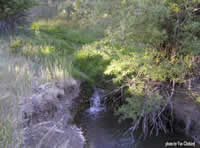 Many wetlands in the Western U.S. have been impacted by historic land uses such as logging, grazing, and road building. The reduction in plant cover and increase in surface runoff leads to channelization and the formation of gullies. The gullying and headcutting continue upstream and drain the wetland.
Many wetlands in the Western U.S. have been impacted by historic land uses such as logging, grazing, and road building. The reduction in plant cover and increase in surface runoff leads to channelization and the formation of gullies. The gullying and headcutting continue upstream and drain the wetland.
Keystone Restoration Ecology has been at the forefront of wetland restoration design in the Southwestern US for over a decade. Our ability to combine the knowledge of geomorphology with the understanding of wet meadow plant communities makes our designs effective and specific to the unique needs of each wetland.
Wetland Restoration Techniques:
Plug and Pond
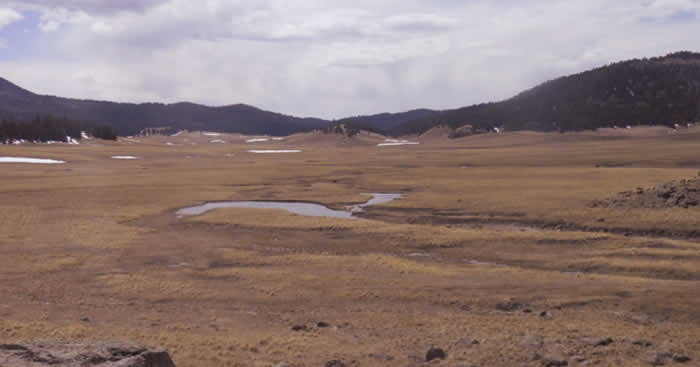
Plug and pond structures are constructed from native soils and wetland sod plugging the channel. Base water flow now can spread across a greater area creating a temporary pond. This water is re-diverted back onto the surface of the wetland into the same historic swales and surfaces formerly irrigated before the erosion and incision.
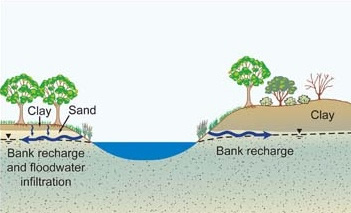 Functions of the Plug and Pond:
Functions of the Plug and Pond:
- Retains snowmelt and rainfall runoff
- Retention increases water table across the wetland area
- Retained snowmelt also returns to the stream as cold ground water during hot, dry summer months.
- Water diverted out of gully and into historic stream channel or wetland
- Wetland vegetation responds to increased water table and begins to thrive
- Headcuts at bottom of wetland become ponds and heal with vegetation.
KRE helped develop the technique for saving the wetland or upland sod and replacing it on top of the dam of the pond, the first time this was implemented in New Mexico. This is now a standard technique in our plug and pond structures at wetland sites, and ensures that the pond is almost invisible once construction is complete.
Zuni Bowl Technique
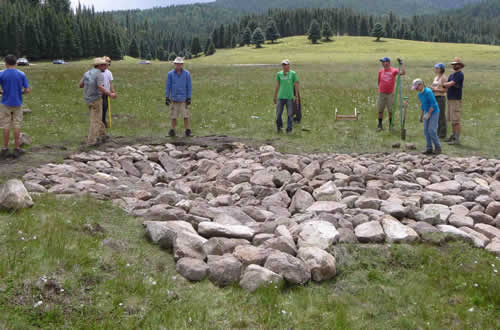 This structure is placed at the "head" or beginning of a gully, preventing the headcut from eroding further upstream. In essence this is a constructed "step pool" where the impact of the waterfall is dissipated by the water in the pool of the zuni bowl. After flow slows or stops, sediments such as sand and clay are left behind in the bowl and anchored by native vegetation growing through the rocks.
This structure is placed at the "head" or beginning of a gully, preventing the headcut from eroding further upstream. In essence this is a constructed "step pool" where the impact of the waterfall is dissipated by the water in the pool of the zuni bowl. After flow slows or stops, sediments such as sand and clay are left behind in the bowl and anchored by native vegetation growing through the rocks.
Rock Rundown Technique
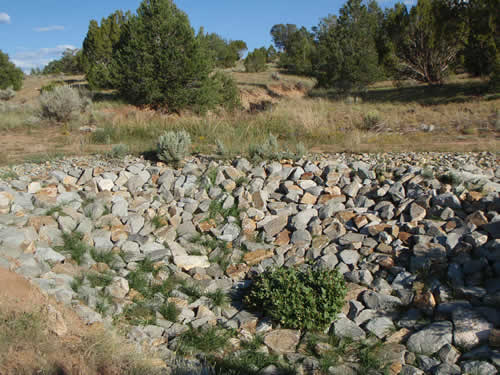 A structure appropriate for areas without much flow, rock rundowns can cover large areas of headcuts and provide resistance to erosion at the entire headcut face. Native grass seed is planted under the rock structure, growing around the rocks and anchoring the structure in place.
A structure appropriate for areas without much flow, rock rundowns can cover large areas of headcuts and provide resistance to erosion at the entire headcut face. Native grass seed is planted under the rock structure, growing around the rocks and anchoring the structure in place.
Working with Wetland Sod
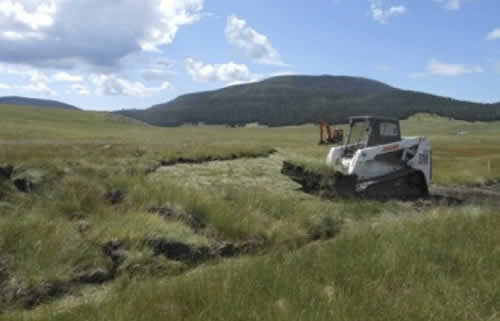 Keystone is a pioneer in the techniques of working with grass or wetland sod in the Southwestern US. Sod is harvested on-site and replaced where appropriate to change the shape of the landform to a stable and healthy geomorphology. We have found each plant species has specific purposes and tolerances.
Keystone is a pioneer in the techniques of working with grass or wetland sod in the Southwestern US. Sod is harvested on-site and replaced where appropriate to change the shape of the landform to a stable and healthy geomorphology. We have found each plant species has specific purposes and tolerances.
Worm Ditch Technique
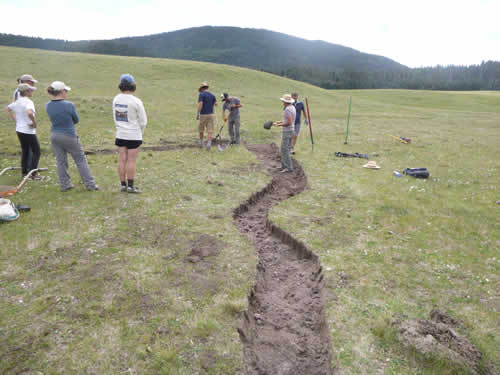 The worm ditch is a meandering channel dug above a headcut to intercept water flow from continuing to gully. It safely spreads and diverts the flow to the channel below the headcut. This simple and effective technique removes most of the water from the headcut, giving it time to heal with thriving native wetland vegetation.
The worm ditch is a meandering channel dug above a headcut to intercept water flow from continuing to gully. It safely spreads and diverts the flow to the channel below the headcut. This simple and effective technique removes most of the water from the headcut, giving it time to heal with thriving native wetland vegetation.
Plants Common in Wetlands
- Sedges
- Many native species of sedges are found; Beaked Sedge (Carex utriculata), Water Sedge (Carex aquatilis), and Nebraska Sedge (Carex nebraskensis) are the most common along stream banks. In drier sites, Field Sedge (Carex praegracilis) can become almost a mono-specific stand.
- Juncus articus (balticus)
- Baltic rush has been renamed arctic rush, but it is still the old standby. This grazing tolerant rush is often the only sign that an area may have been a wetland and can persist for decades in a disturbed site, as its roots can reach a water table 30 feet down. It can easily be found in the fall where the intense golden color of its foliage stands out among the straw-colored grasses around it.
- Three-square
- This plant is a vigorous grower on saturated stream banks in the Southwest. Its sod can be so dense as to be impenetrable, and resists erosion easily. Over time, three-square can narrow a channel and cause a change in channel type from a Rosgen B to E channel.
- Spikerush (Eleocharis species)
- These species are early-successional invaders on sediment in wetlands. While usually replaced by a larger, more vigorous wetland plants, they can help by capturing some of the fines that are deposited in eddies along a stream. Knowing that deposition is occurring and being colonized by spikerush can be an indicator of a successful project evolving towards a stable geomorphology.
- Bulrush
- Soft-stemmed bulrush can grow in deep water and anchor fine sediments in pools and wetland ponds. This species can replace cattails in the successional sequence and become the climax species in an emergent wetland. Bulrush root plugs have been used to anchor sediments in many sites, and anchor the sediments to resist erosion.
- Coyote willows
- Many useful riparian plants are clonal species that spread quickly through the available habitat by suckering and root sprouting. Coyote or sandbar willow can be planted throughout most of the year as cuttings, the branches produce rooting hormone and will take root and grow. Over time, coyote willows will colonize banks and floodplains by suckering and anchor the sediment in place. They also provide the function of shading the stream from the hot mid-day sun.